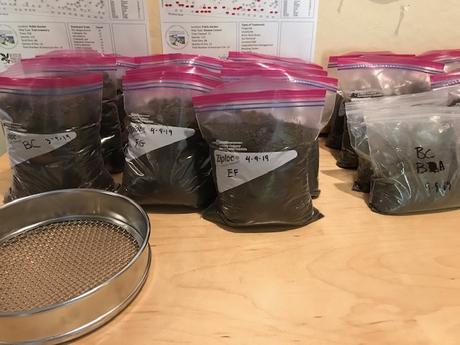
A single teaspoon sample of healthy soil can contain over 6 billion microorganisms. Yes, that's 6 billion with a "b"! This mighty ecosystem is crucial to the health of our parks, necessary to feed the flowers, trees, and shrubs that adorn our beloved urban oases.
This fall, the Friends conducted a soil sampling for the turf in each of our three parks: the Common, the Public Garden, and the Mall. This year is the first year of gathering annual data for all three parks and will enable us to set baselines for existing conditions, identify areas of strength and weakness.
The samples have been sent to two separate labs: one to analyze the chemical composition of the soils, and one to identify the biologic composition of the soil environment. A soil's chemical composition includes macronutrients (like nitrogen, phosphorus, and potassium), micronutrients (like iron, boron, and zinc) as well as organic matter content and pH levels. The biological composition of soil is made up of microorganism species (bacteria, fungi, protozoa, and nematodes) and reveals species' type, density, and diversity throughout the soil.
Through interdependent relationships formed with plants, these biologic communities fuel organic matter decomposition, which is the basis of natural nutrient cycling - the way nature has fertilized plants for eons - and can contribute to disease resistance. In some cases, these microorganisms can combat pest populations by preventing them from growing. Predatory nematodes are an example of this system of natural defenses at work, where the nematodes can cause interference with the grubs that eat turf roots and successfully return balance to the soil environment.
Results from annual soil tests will give us a comprehensive look inside soil environments to help identify specific areas of need for our nutrient management and revitalization program. Yet, even with additional data points and increasing the specificity of treatments, there is unfortunately no one "silver bullet" treatment solution for these heavily utilized and well-loved public spaces.
This data will also help us identify and address the variables creating any changes or decline, which might otherwise have stayed unnoticed. Using a science-driven approach to soil health, we plan to leverage this data collection and analysis to drive innovative and strategic methods to improve existing conditions.
In the next months, we will get back the results from the soil testing and learn what that means for our nutrient management and revitalization programs for each of the parks today and moving forward. Needless to say, this is an exciting step towards a greener, healthier set of parks, for the turf, trees, and all of us who use and enjoy these wonderful spaces.
